Epiphone Kirk Hammett 'Greeny' 1959 Les Paul Standard review – it may be $1.5k, but this is the best-quality Epiphone we've ever played… and better than some Gibson USA builds
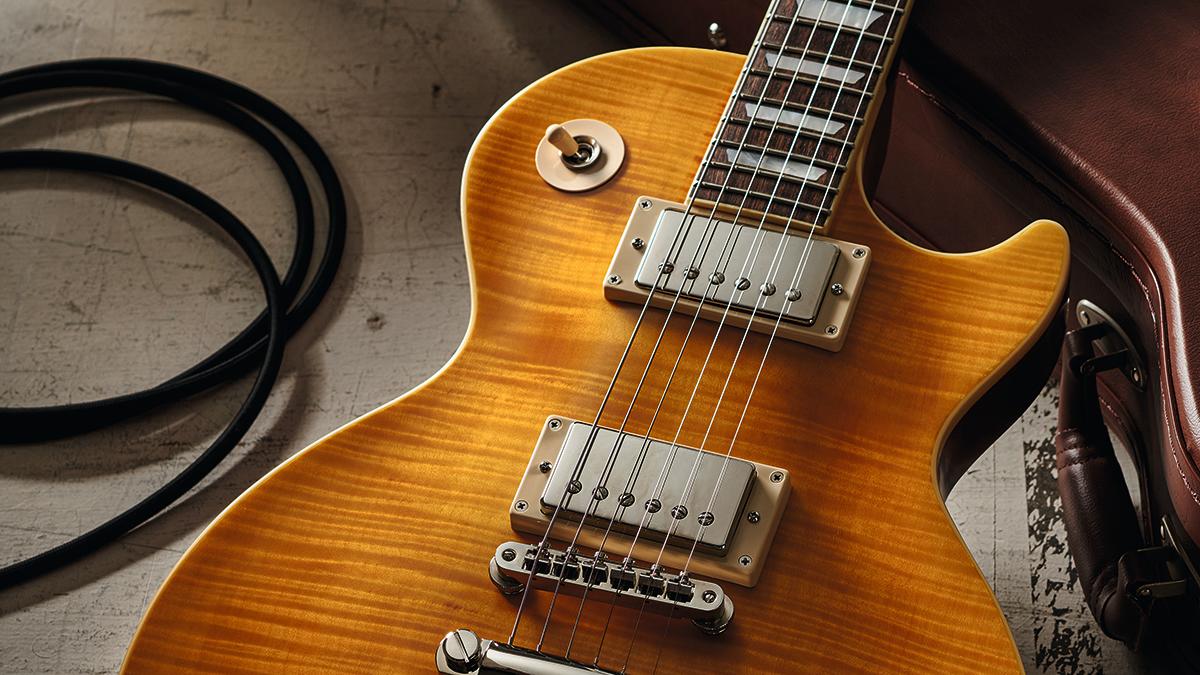
One of the worst kept secrets of 2023 was this Epiphone ‘Greeny’. “The Gibson USAs are great,” Kirk Hammett told us back in issue 499, “but my favorite version of Greeny is probably the Epiphone.” Except no-one outside of Gibson knew anything about it!
For some, that marketing blip – which came just at the time Gibson was actually launching its USA production version of Greeny – might have been a bit of a PR disaster, but it’s just another footnote in the continuing story of this 1959 Les Paul that was once owned by Peter Green. They say guitars have stories, but there’s a War And Peace-sized book on this one. And probably a second volume, too.
Yet even though the far-from-secret launch of this guitar has barely passed, our forum friends got into quite a lather. At £1,499/$1,499, it might be half the price of the USA production guitar, but in terms of Epiphone, that’s pretty salty, isn’t it?
In its defense, this new Greeny is an ‘Inspired by Gibson Custom Shop’ Epiphone: an elite collection that includes a 1961 Les Paul SG Standard, a 1959 Les Paul Standard, and a 1958 Korina Flying V and Explorer.
While these range in price from $879 to $1,299, it’s the ’59 Les Paul that interests us. Its full list price is $999, and it comes in two colors. Greeny, then, is less a completely new release – it’s the existing 1959 Les Paul Standard in a single color and with a pickup swap... for quite a bit more money.
Epiphone says that these ‘Inspired by Gibson Custom Shop’ guitars aim to “recreate inspired versions of legendary instruments for every stage” – and Greeny is the perfect fit. So is its tan-colored hard case. But when we lift out our new Greeny model, the first thing we notice is the weight: at 3.91kg (8.6lb), it’s lightweight for a Les Paul, old or new.
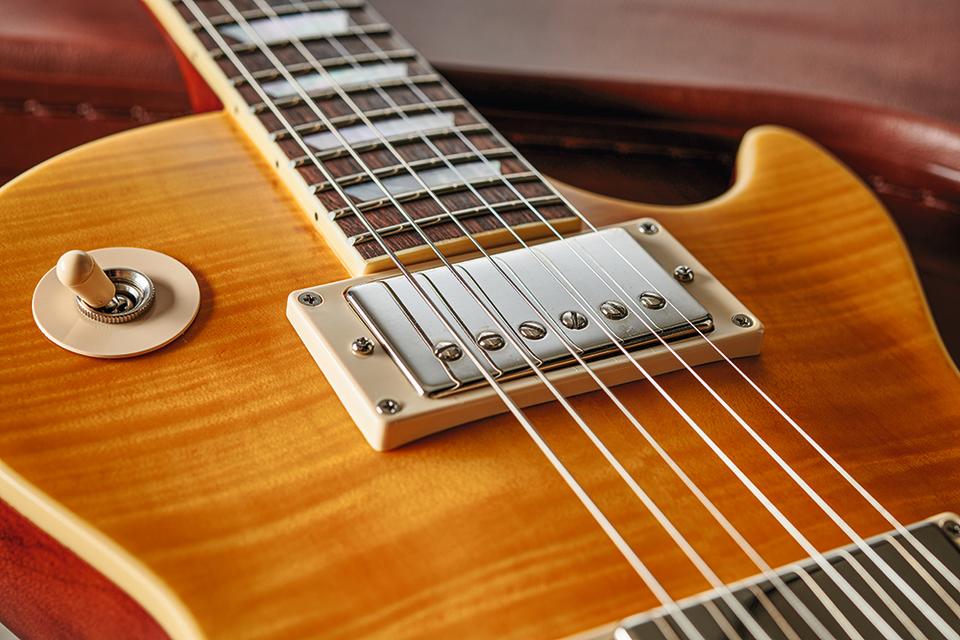
So it’s a good start, but the very next thing we notice is the finish. Obviously it’s not relic'd to match the original, but the top is what looks like off-the-gun satin – there’s a slight texture to it and it’s more matte than satin. However, the back, sides, and neck back have a beautiful satin sheen that’s super smooth to the touch and a big difference to the over-glossy finishes we still see on way too many Eastern Asian guitars. This finish has some serious class.
The top’s flame maple is a veneer that sits on a nicely dished solid maple top. Its light yellow color looks a little like one of those recent Faded Les Pauls, but it’s superbly bound, and the top edges well rounded – unlike the sharp edges of the USA Greeny we looked at earlier in the year. Through the dark brown tinted back finish you can clearly see some very classic mahogany-like grain pattern and that it’s a two-piece, center-joined spread.
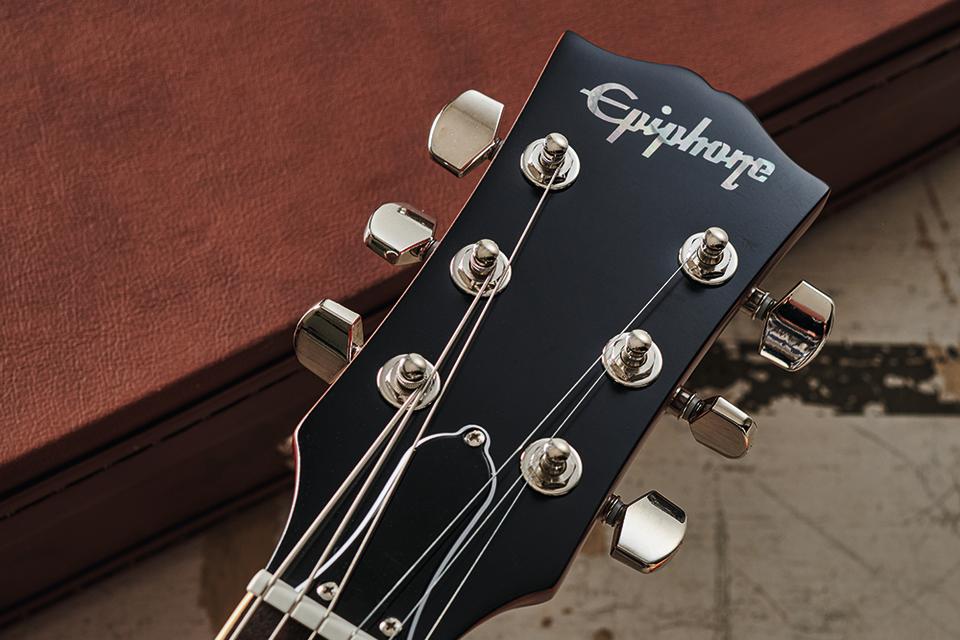
The neck appears to be one-piece mahogany with a narrow tenon that extends into the body under the neck pickup. The fingerboard is Indian laurel, not rosewood, and has a mid-brown and lightly striped appearance. When we changed strings we gave the frets a quick polish and oiled the fingerboard, which, we have to say, now looks and feels very classy. Those inlays appear to be mother-of-pearl, probably laminated, that ‘dance’ nicely in the light.
As we’re seeing more with the higher line Epiphones, they’re using Gibson
USA pickups and these are obviously Greenybuckers, the same that are used on the £3k USA model and the much more expensive Custom Shop versions. The only difference is that those Custom Shop sets have aged covers and aren’t potted; ours are wax-potted with shiny nickel covers.
But just play the guitar and they’ll soon age nicely. Epiphone’s LockTone tune-o-matic and stop tailpiece are credible parts that won’t fall off when you go to restring, and tuners are Grover Rotomatics with modern-style buttons, the same type as the USA model.
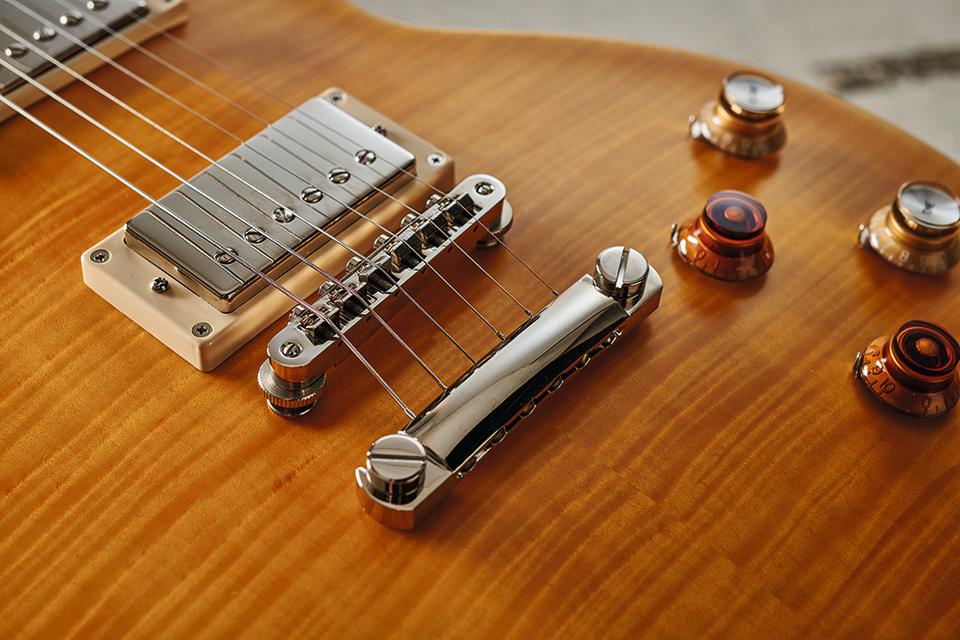
Under the hood
The rear cavity here is pretty tidy but unscreened, like the cover plate, and without the grounding plate used on the USA version. The primary difference, however, is that the Epiphone is wired – as the 1959 original would have been – with ‘50s-style’ wiring, not ‘modern’ wiring. All the pots are CTS with a nominal 500kohms rating. Unlike the USA guitar, the capacitors here are Mallory, although they have the same .022μF values.
Wired '50s-style like this, there is some interaction between the volume and tone. So if you pull back the volume, then reduce the tone control, the sound thins out. When you wind the tone back up it almost acts like a volume. You should also find when you reduce the volume the high-end is retained more than with modern-style wiring. Of course, if you want to try modern wiring, you just need to move the tone control from the middle lug on the volume to the input lug, where the pickup’s hot lead is wired.
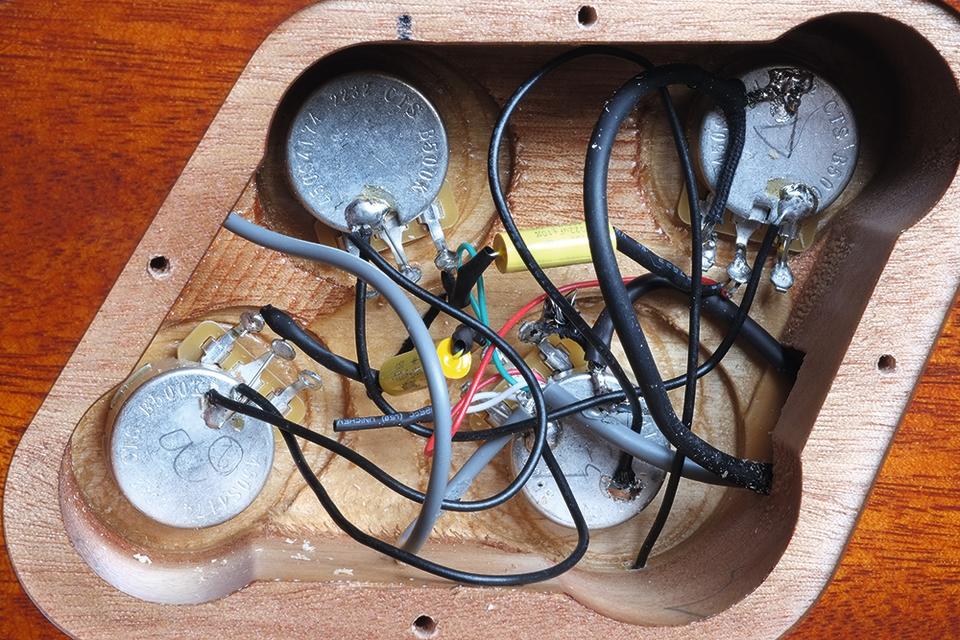
As we say, the Greenybuckers – which are wax-potted here (aftermarket versions are unpotted) – are on the hotter side of the PAF scale: ours measured 8.52k at the bridge, the neck measured 8.25k, and both use an Alnico II magnet. Gibson doesn’t specify wire type or gauge, and the out-of-phase sound is created by reversing the neck pickup’s magnet.
“The [Greeny] guitar has been analyzed more than once here,” Gibson USA’s Jason Davidson told us back in issue 504, “but the pickup specifications were confirmed with Kirk’s tech as well. Then we did a lot of ear-testing to make sure the sound was there. I remember Jared [Brandon, Pickup Shop product manager and designer] made three batches: they were all very close, but we went to our sound lab with Matt Kohler [VP of product at Gibson Brands].
“Matt has a really good ear and he’d listened to Kirk playing Greeny several times: he had a pretty good idea of what it sounded like when Kirk played it. Eventually, we all agreed on which set we thought was right and Kirk gave a big thumbs up and obviously compared them to the real thing.”
Feel & Sounds
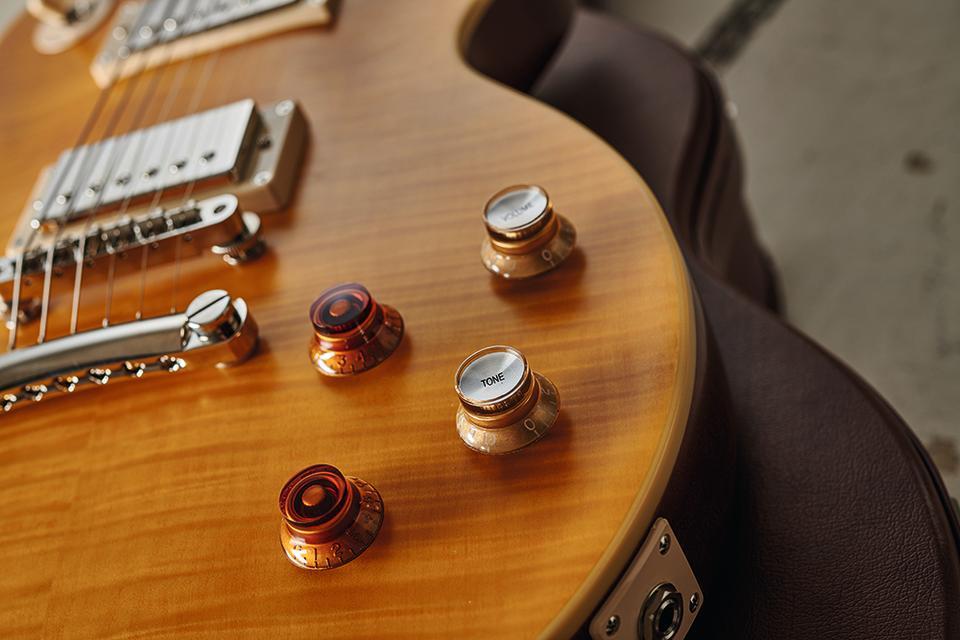
If you like larger, palm-filling neck profiles, you’ll be at home with this one. Dimensionally, it’s slightly deeper than the USA Greeny we looked at: 22.8mm at the 1st fret, 25.6mm at the 12th, with a deep C profile. The fretwork is good, the gauge fairly standard Gibson, approximately 2.3mm wide by 1.2mm high, although
here the fret ends sit over the binding and there are no nibs. As we said, a little final fret polishing wouldn’t go amiss, but if you shut your eyes you could be playing a much higher-priced vintage-style Les Paul.
To be honest, we could say the same about the sounds here. The Greenybuckers sit on the hotter side of the PAF output range and that gives us a little more punch and sizzle at the bridge; the neck is thick, warm and majestic. It’s not the trendy, low-powered ‘Tele on steroids’, but, hey, you can use the volume controls, which really work, with '50s wiring (see Under The Hood on the previous page).
If you shut your eyes you could be playing a much higher-priced vintage-style Les Paul
Then we have the fabled out-of-phase sounds in middle position on the three-way toggle, which provide a sea of subtly different, slight, or pronounced nasally voices when used with the independent volume and tones.
We still wish we could electronically restore the phase. Being fans of the standard dual-humbucker mix, if this was our only ’Paul we’d miss that, not least on a function gig where every song seems to require a different voice. But as well as the rather good default classic rock sounds of the solo ’buckers, there’s a lot to explore here.
Verdict
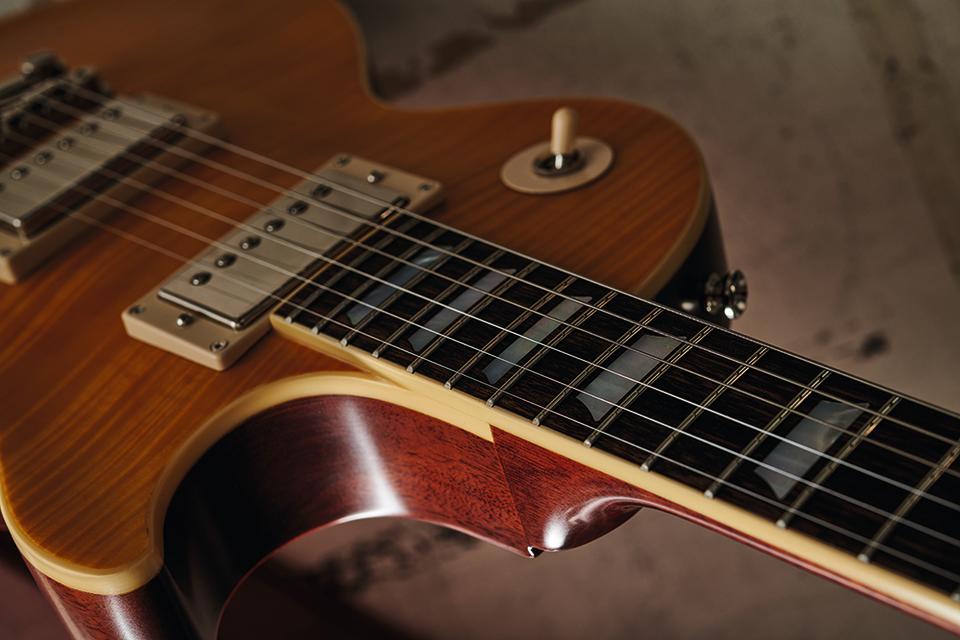
Where to start? A £1.4k new Epiphone? Someone’s having a laugh, aren’t they?
You could buy an ‘Inspired by Gibson Custom Shop’ 1959 Les Paul for £969, budget for a set of Greenybuckers from the Pickup Shop (£319) and still be in pocket. You could also buy a Gibson USA Les Paul Tribute for less money (not to mention a Junior), and then there’s the more recently released, stripped-down USA Les Paul Modern Lite at the same price. Isn’t this just an overpriced ‘Chibson’ with the wrong name on the headstock?
Well, we’d strongly suggest if you’re remotely interested in saving some cash that you A/B this Epiphone with the USA Greeny. You might be surprised. To our hands, ears and eyes – irrespective of where it’s made or whether we have a faux maple top, and so on – it’s quite simply the best-quality-level Epiphone Les Paul we’ve had in our hands and, to be honest, a considerably better proposition than some of Gibson USA’s low-end models that often feel Made In Hurry. In contrast, there’s some excellent craft here, a great finish and plenty of sounds to explore
Specs

PRICE: £1,499/$1,499 (inc case)
ORIGIN: China
TYPE: Single-cutaway, solidbody electric
BODY: 2-piece mahogany with carved maple top faced with AAA flame maple veneer
NECK: 1-piece mahogany, ‘custom Greeny’ profile, glued-in
SCALE LENGTH: 629mm (24.75”)
NUT/WIDTH: Graph Tech/42.64mm
FINGERBOARD: Single-bound laurel, mother of pearl trapezoid inlays, 305mm (12”) radius
FRETS: 22, medium jumbo
HARDWARE: Epiphone LockTone ABR tune- o-matic bridge, and stopbar tailpiece, Grover Rotomatic tuners w/ ‘modern’ buttons – nickel plated
STRING SPACING, BRIDGE: 51.5mm
ELECTRICS: Covered Gibson Greenybucker set w/ reversed magnet polarity (neck), 3-way toggle pickup selector switch, volume and tone for each pickup
WEIGHT (kg/lb): 3.91/8.6
OPTIONS: None
RANGE OPTIONS: Gibson Custom Kirk Hammett ‘Greeny’ 1959 Les Paul Standard ($19,999) and USA Greeny ($3,199)
LEFT-HANDERS: No
FINISHES: Greeny Burst (as reviewed) – satin front, lightly burnished back, sides and neck
CONTACT: Epiphone

